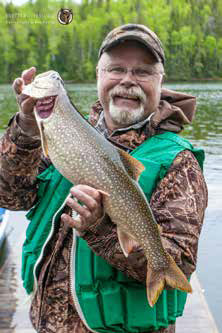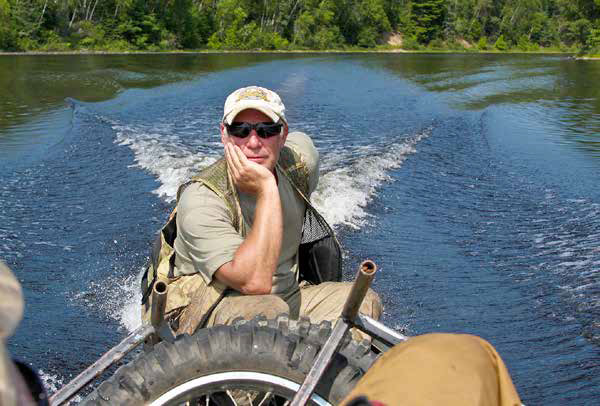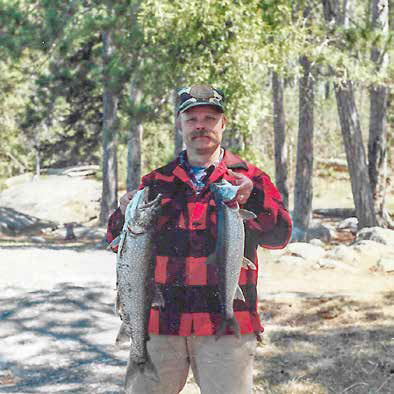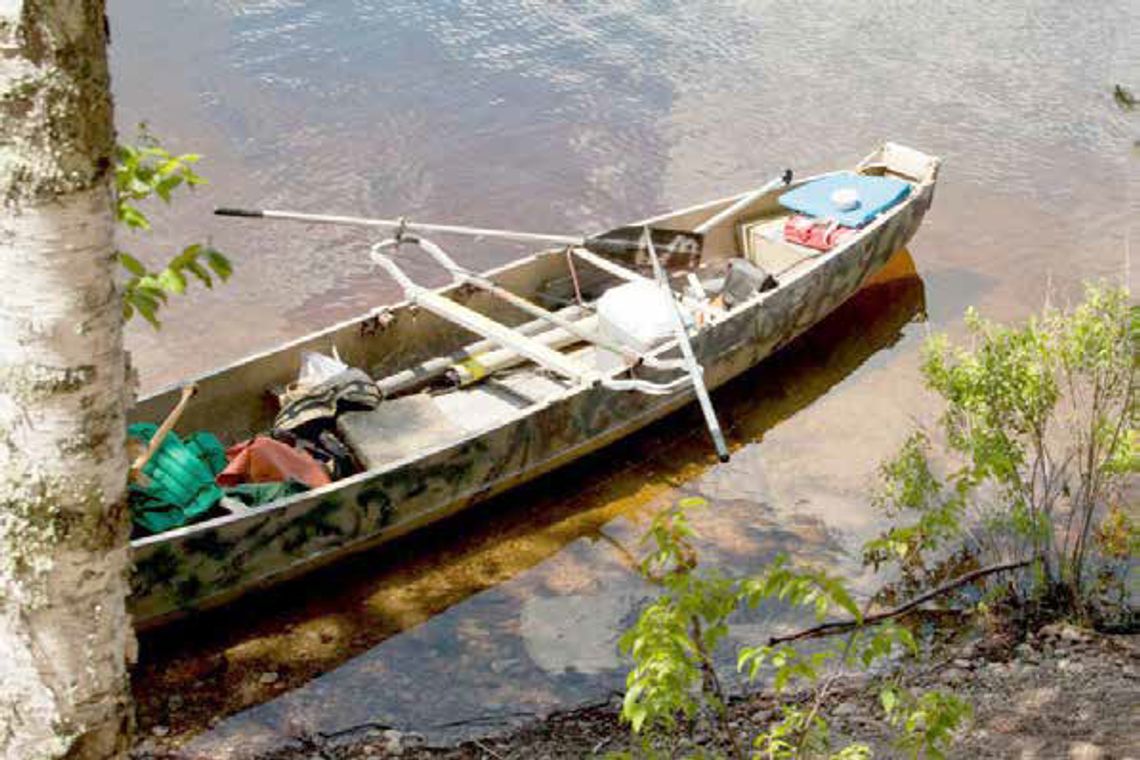Chapter 9 - Hound Dog
“It’s open!”
“It” referred to the waterway between Moose Lake and Basswood. A group of us made a trip to fish lake trout in North Bay as soon as the ice went out, an annual affair. Bob Braff, having a contact in the Forest Service, would let us know as soon as a pilot would see that the ice was gone enough to travel through.
It would take a couple of weeks of preparation to make this journey. We would be traveling into, and fishing within the borders of Canada. It was a fairly simple process and paperwork was minimal in those days.
Fishing licenses would have to be bought and RABC permits obtained. For me, that usually meant a trip to Fort Francis to make the necessary arrangements.
Our operation was not complicated. We would start at the Moose Lake public landing and drop in our 19-foot square stern canoes, pushed by 15 horse motors. It was before the “permit” season, and we could enter the BWCA without one. The route proceeded down Moose, to Newfound and Sucker Lakes, and crossed on the Canadian side of Prairie Portage. We would continue to motor to the end of Inlet Bay, drop the motors and paddle across Bayley Bay to the portage into Burke. Once in Burke, we would make our way to the north end and portage once more into the trout laden waters of North Bay of Basswood Lake.
This trip we had two canoes.
Doug Drechsler, Jim Haugen and Larry Simonich were in one canoe, and Tom Wetzel, Wayne Monsen and I were in the other.
When we reached the North Bay side, Jim took his canoe north while we stayed near the portage.
Splitting up to cover more fishable water seemed prudent.
Once in place, we strung frozen ciscoes on to treble hooks, used the canoe to carry the lines about 75 yards from shore, and then returned to land to wait for the lake trout to pick up the dead ciscoes off the bottom. This method was efficient and tended to follow our style of winter fishing with tip ups on the ice while we enjoyed Zup’s polish boiled over a fire while sitting on shore. Laker fishing being what it is, catching one or two made for a successful trip. Seldom did we catch the three fish limit we were allowed at the time.
This trip was different. We started catching fish right away. It was a steady drumbeat of, catch a fish, carry the line out to a spot offshore, and catching another fish. These were pleasant days.
Aside from the workout going in and out - Haugen once assured me that it took 8,310 paddle strokes to cross Burke Lake - the rest of the day was made up of short forays to set new ciscoes, spreading whatever fare we brought for lunch to last the day and to continuously drink coffee.
We’d keep a fire going to cook polish sausage and heat water for coffee – and for a bit of ambiance as well. Always good to smell of wood smoke when you get home.
There was plenty of time to tell old stories, catch up on families and settle all the problems that plagued the world. Most years we enjoyed warm and sunny days with little wind. Certainly, a much-needed respite after a long winter.
Tom and I worked together at Ely Memorial High School and had gone on many trips together.
Wayne was a friend of Tom’s from church and had spent much less time outdoors. His tackle was sparse, and his reel hadn’t been used in years. The spool had barely thirty yards of line on it. I always bring extra line and used a nail knot to splice another hundred yards of 12-pound test on the end of it. Wayne caught the biggest fish of the day, and aside from the great battle it fought, the next biggest excitement was when the nail knot finally made it to the spool! We all held our breath until it was securely wound under several laps of line.
By the middle of the afternoon, we had eight of our nine allowed. With only one under our limit, we discussed whether we should have three lines in the water while only one more fish could be in our possession. I was chosen to bring a couple of fish back into the woods while we attempted to catch our last one. The problem was, in Canada you aren’t supposed to party fish. Only one of us should have been fishing to catch the ninth fish, but at this late date, I can’t remember who had only caught two. We probably didn’t think a whole lot about it then, either. In any case, having it look like we had room for three fish on the stringer would – at the surface – look better if someone happened to stop by.
As I looked for a likely place to hide the fish, I spotted a red pine that had recently fallen over and dropped its needles into a deep pile on the forest floor. The needles were a bright red and must have lain at least 18 inches deep. I dug into the pile, buried the fish and looked with satisfaction at a perfect hiding spot.
When I got back to the shoreline, Wetz asked me if I found a good place.
“Even a hound dog couldn’t find ‘em” I replied confidently!
Well, at three o’clock, all three of our lines went out at the same time. And, even more startling, we caught all three fish! We were entitled to one, so we worked hard at releasing the other two. The first one swam away, no problem.
But the second one had taken the hook deep in its gullet and after several minutes we gave up. We were one over, so we didn’t put our lines out again. With the two fish ducked back in the woods, we looked legal out at the shoreline.
We figured the other boat surely hadn’t limited out, so if we just waited for them to get back, we should be good. We sat on the shoreline, ate some more polish and enjoyed our time on a beautiful spring day.
The other crew was supposed to meet back with us at 5 o’clock.
Five came and went, and so did 5:30. Geez, they must have had some problem, so we started loading the canoe with our gear to go out and find them. That’s when we heard it. An outboard motor starting up where there wasn’t supposed to be any outboard motors. Here came a boat from Cigar Island with two people in it. As they got closer, we could see one was dressed in a uniform, and the other was – Ken Schleuter – the conservation officer from Babbitt! As it turned out, the uniformed gentleman was indeed an Ontario DNR enforcement officer. Ken was along as an observer. If there was any dispute, he would be a witness to ambiguities that might happen. The officer engaged us.
“Can I see your licenses?”
“Do you have a rabies permit (RABC)?” “Nice day!”
“Good fishing!”
He was a pleasant enough fellow. As he was talking to us, Ken slowly ambled back into the woods. Tom and I stole a couple of glances at each other and tried to remain as calm as we could. A few minutes later he came out dragging the two fish by their still engorged leaders – and maybe a couple of red pine needles hanging from his nose and the bill of his cap!
The officer dryly said, “I see my hound dog found a couple of fish!”
Wetz and I looked at each other gobsmacked! Did they plant microphones on the shoreline? Could they hear us talking from nearly a mile away over the water? How did they find the fish so easily? The exact term “hound dog” couldn’t be a coincidence, could it?
Most of the answers came quickly. They had been watching us with spotting scopes all day.
We stumbled all over each other trying to come clean with what happened and how we tried our best to not be over the limit.
“We saw you catch three fish at 3:00. We watched you release one fish and try to release another. We then observed that you quit fishing. We also saw you bring those fish into the woods.”
The officer was gentle with us.
When we asked what was going to happen now, he explained it this way: “When I get back to the office this evening, I’ll send a report to headquarters in Toronto. They’ll set a court date, and you are required to show up. The law says the fine could be up to $10,000.
I’m going to write a ticket for one fish over the limit – if you can decide whose name will go on it. Usually, the fine ends up being about $50. If the probable fine is less than the cost of a trip to Toronto, your need to show up is waived. I’ll go before the magistrate and explain what I saw and found. When I’m done with that, I turn around and act as your attorney. The better you treat me, the better attorney I am!”
About this time, Jim and his crew showed up. Indeed, they had only caught four fish. Little good it did us now! Tom and Wayne and I flipped coins to see whose name would go on the ticket.
Though there has been some dispute in the time since, Wetzel’s name ended up in the court records. “What were we supposed to do with a fish that was going to die anyway?” we asked.
“Only thing to do is to cut the line and let it drift off” he said.
“You’ll be glad to know that I’ll take the extra fish and drop it off at the nursing home tonight. They always like to see me coming!
And who knows. Maybe that ticket won’t make it back home with me.”
Tom had a smile all the way back down the lake that night.
What a story this would be! When I got home, I immediately called Schleuter. I don’t like to be in a situation where I might be looked at more closely because of past deeds. He appreciated the call and told me that he’d never seen that warden so lenient. He could have taken all the fish, our gear and our canoes, and call for a plane to give us a ride to Atikoken to drop us off. “The best thing that happened to you today is that we had watched throughout the day.
If we had come up to you at the last minute and found you with too many fish, it would have been a different story.”
Alas, the ticket did make it to court and eventually Tom met with us to get our share of the fine. It was $50 Canadian, which amounted to about $35 U.S. A cheap cost for such a great story.
We are not a crew of rule-breakers. I don’t recall ever having too many fish after that. We’ve worn the scales off a pile of walleyes counting and recounting after a day on Basswood. And yet – maybe because we try to play by the rules – the Hound Dog story is one of our favorites to tell. If you ever hear those who were along that day refer to me as “Hound Dog Hupila”, you’ll know why!
And……we never learned if there was a planted microphone!





.jpg)










